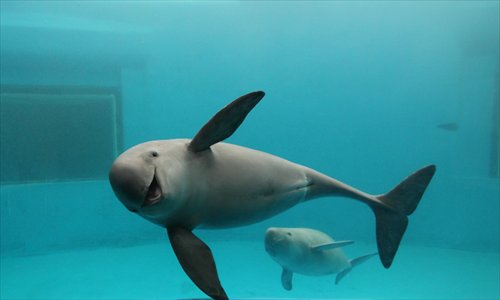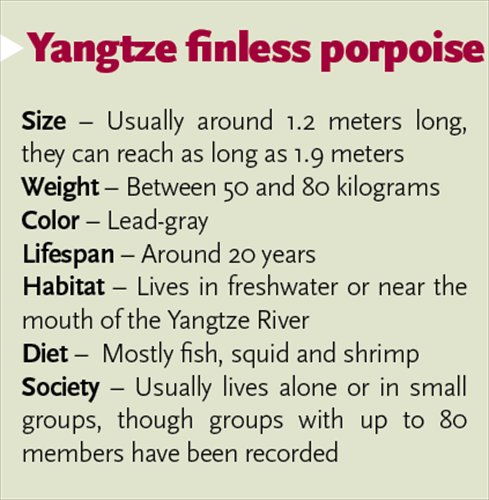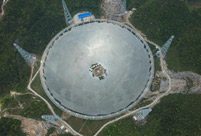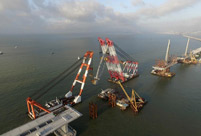

With a population that has shrunk to become even smaller than that of the endangered giant panda, protecting the Yangtze finless porpoise is an urgent task for Chinese scientists and fishery administrators.

Yangtze finless porpoise
In March 2015, eight Yangtze finless porpoises arrived in their new home, around 500 kilometers away from where they grew up.
Compared with the jam-packed Yangtze River, dubbed the "golden water route" because of the huge volume of trade that moves up and down Asia's longest river, the porpoises' new home is expected to be the "ark" that will save the critically endangered species.
This relocation program may be the last chance to save the species from extinction. Their new home was once part of the Yangtze, before the river shifted its route toward the sea. Administered by the Ministry of Agriculture, several institutions that specialize in porpoise protection and research have joined the fishery administration to move the water mammals, thepaper.cn reported.
Yangtze finless porpoises are on the brink of extinction. A study conducted by the China Academy of Sciences (CAS)' Institute of Hydrobiology found there were only 1,040 Yangtze porpoises still alive in 2012, less than 60 percent of the giant panda population. There may be none left in as few as five years. This will be a huge blow to the eco-system of the Yangtze, sometimes called China's Amazon due to the wealth of biodiversity it once had. A species native and unique to the river, Yangtze finless porpoises are at the top of the river's food chain and their fate reflects the health of the whole river.
"The (now probably extinct) baiji dolphins have left us, now the finless porpoises may be next," CAS expert Wang Ding said. "Human beings may follow them."
Bye-bye baiji
Nineteen ships lined up on the shore to search for the finless porpoises, when suddenly the lead-gray animals surfaced near the far bank. The flagship directed others to approach the animals and surround them.
The finless porpoises live in the Yangtze and two of China's largest lakes - the Dongting and Poyang - which are both linked to the river. After spotting them when they surface to breathe, the researchers drive them into the shallows while using echolocation to track them.
The plan is to move the porpoises to Tian'ezhou, or Swan Island, a State-level nature reserve dedicated to protecting the river's porpoises. It was established in 1990 to save the Yangtze's baiji dolphins. However, only one baiji was ever moved there and now the species is considered functionally extinct.
Gao Daobin, former deputy director of the Swan Island reserve, led the program to relocate the baiji. "We found several baiji, but the local government wouldn't let us relocate them and said they would protect them. We could only relocate one baiji that we found elsewhere, and it ended up dying in the nature reserve alone," he said.
Wang Sheng, a researcher at the CAS Institute of Hydrobiology, often reflects on his experiences with the baiji. In the summer of 2006, he was part of a multinational group of researchers that looked for the few remaining baiji. They spent more than a month traveling more than 3,000 kilometers on the Yangtze between Yichang, Central China's Hubei Province and Shanghai. Their efforts were in vain and Wang, who had studied whales for two decades, admitted that the team's search was fruitless to the media.
In 2007, researchers declared that the baiji was probably extinct.
It's extremely rare for two types of porpoises or dolphins to live in the same river. Aside from the Yangtze, only the Amazon has also been home to two kinds of dolphins.
Scientists believe that the number of baiji began to plunge after the 1950s as human activities on the river increased. By the end of the 1990's, researchers estimated that there were only a few dozen baiji left in the river.
Porpoise haven
The Swan Island nature reserve, in Shishou, Hubei, received five migrant finless porpoises in 1990. Researchers wouldn't or couldn't directly move the baiji there, so they first moved porpoises there as an experiment.
The first-generation immigrants quickly adapted to their new home, and their population has grown steadily. In most of the years since then, three to six porpoises have been born there, and the number of births is increasing year-on-year. This year, nine finless porpoises are expected to be born in Swan Island, pushing the total population to 70. Swan Island is the only place where the porpoises' population is increasing.
The 21 kilometers of old Yangtze riverbed around Swan Island are particularly suited to be a new home for these endangered animals. As part of the old course of the Yangtze, it had remained largely pristine, in contrast with the bustling traffic and industrialization along the Yangtze. However, the animals still face challenges here. In 2008, southern China was hit by an unusually harsh winter, and Swan Island's lake was covered in 30 centimeters of ice. In order to surface to breathe, the porpoises had to headbutt their way through the ice. Six were later found dead from head wounds. No one expected that a lake in the usually warm south would freeze.
Moreover, the Economic Information Daily reported that the area has also been faced with increasing environmental pressure caused by economic development today.

Zhang Zhenhua, deputy director of the reserve, said the water quality around Swan Island is now even worse than that in the Yangtze. Although farming is forbidden in the reserve's core area, some villagers simply ignore the ban, and there is no punishment to deter them. The nature reserve, which was planned to be about 70,000 mu (4,666 hectares), has shrunk to around 30,000 mu due to the encroachment of farming.
According to Zhang, in 2014 construction started on a food processing factory in the reserve's protected zone. The city government refused to act, and the nature reserve had to report the problem to the provincial government before the factory was dismantled.
"We can't put all the eggs in one basket," Wang said. As the porpoise population expands, inbreeding will eventually harm the community.
In 2012, the Ministry of Agriculture held a symposium on porpoise protection. During the meeting, experts and fishery administrators agreed that given that conditions in the Yangtze will not radically improve in the short term, it is necessary to establish new reserves for finless porpoises. After the meeting, the ministry entrusted CAS to draft a Yangtze Finless Porpoise Salvation Plan, which focused efforts on finding reserves. Wang Ding said they hope to establish five to 10 natural reserves in the next 10 years on the middle and lower reaches of the Yangtze, and porpoises will be rotated among the preserves to ensure genetic diversity.
Three years ago, the World Wildlife Fund (WWF) proposed establishing another reserve for finless porpoises in Hewangmiao, Hubei. After surveying the site, scientists found the environment there had been well preserved. Local people fish in the lake, which is regularly filled by the Yangtze and has no industrial pollution. It could well accommodate 100 porpoises if maintained properly.
Under the CAS plan, eight young and strong porpoises were selected, aged between 2 and 5, and were relocated to Hewangmiao and Swan Island.
 Five made-in-China hi-tech breakthroughs
Five made-in-China hi-tech breakthroughs Beijing Style: Hot pants
Beijing Style: Hot pants HK-Zhuhai-Macao Bridge to open to traffic
HK-Zhuhai-Macao Bridge to open to traffic China opens its first combined transport service to Nepal
China opens its first combined transport service to Nepal Students take stylish bikini graduations photos
Students take stylish bikini graduations photos Charming dancing students pose for graduation photos
Charming dancing students pose for graduation photos Guizhou, Yunnan section of Shanghai-Kunming railway connected
Guizhou, Yunnan section of Shanghai-Kunming railway connected Naked models transformed into landscapes, birds and even DRAGONS by body painting artist
Naked models transformed into landscapes, birds and even DRAGONS by body painting artist World’s biggest cruise ship Harmony of the Seas to start maiden voyage
World’s biggest cruise ship Harmony of the Seas to start maiden voyage Top 20 hottest women in the world in 2014
Top 20 hottest women in the world in 2014 Top 10 hardest languages to learn
Top 10 hardest languages to learn 10 Chinese female stars with most beautiful faces
10 Chinese female stars with most beautiful faces China’s Top 10 Unique Bridges, Highways and Roads
China’s Top 10 Unique Bridges, Highways and Roads Live streamer stirs up controversy by playing a woman
Live streamer stirs up controversy by playing a woman Avoiding middle-income trap relies on Chinese reforms
Avoiding middle-income trap relies on Chinese reforms Q&A site becoming platform for celebrity gossip experts
Q&A site becoming platform for celebrity gossip experts Protests erupt over college enrollment for minorities at Beijing high school
Protests erupt over college enrollment for minorities at Beijing high schoolDay|Week